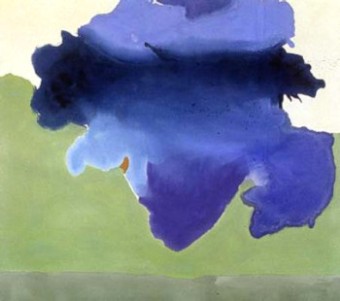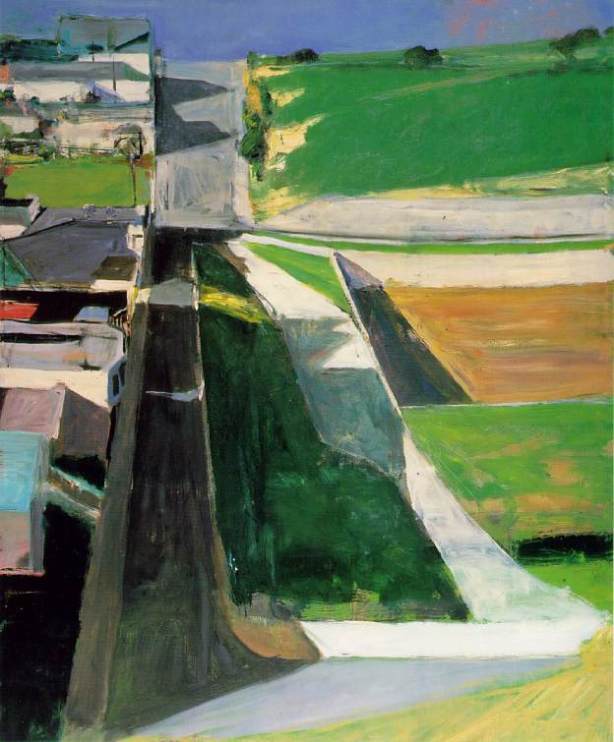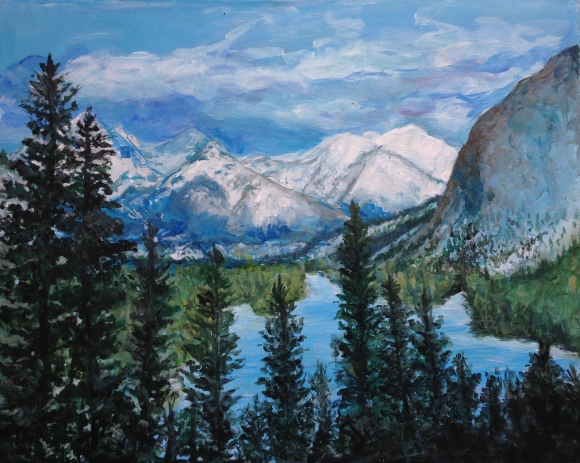Helen Frankenthaler & Richard Diebenkorn
Mitchell Kemp
Helen Frankenthaler uses staining in a unique way to achieve rich colours and unique shapes. Her process is significant and points to the significance of the material. Her techniques are the result of centuries of alla prima painting beginning with Hieronymus Bosch who first drew with paint directly on the canvas. Frankenthaler’s critical input to art discourse surrounded that of abstract expressionism. More specifically Colour Fielding, a movement focusing on flat shape and colour. This brought emphasis to the colour itself rather than the painterly qualities of a work. Frankenthaler’s painting titled The Bay is an example of what she can achieve with her process and an example of colour fielding. Richard Diebenkorn also worked in colour fielding and abstract expressionism. He later moved into more representational work and found success in that as well. He was influenced by the work of traditional modernists such as Cezanne, Matisse, and Mondrian. Diebenkorn was concerned with integrity and morality in his painting which was “difficult to articulate but unmistakably present when achieved.” His painting titled Cityscape I is an example of his more representative work however still shows an interest in colour fielding.
The Bay and Cityscape I use shape and colour as a subject matter. The large scale is an important element in both works that confronts and engages the viewer. Frankenthaler achieves this through her process. By applying the paints directly onto the canvas she allows the pigments to soak in creating a variety of hues and values. This can be seen in the blue shape dominating the painting. Based on the title this blue form seems to reference a body of water, amplified by the deep tonal changes in the blue and the blooming colours throughout. These formal qualities help reveal the wet process used to create it giving further significance to the title. Diebenkorn objectifies his colours by blocking them into a grid like pattern. He explores space with his use of colour sending them into the background and bringing some to the front. He emphasizes the surface of the canvas by overlapping colours to create fluidity and movement perhaps to speak to the subject matter visually rather than literally. This intersection between representation and abstraction creates tension and questions the forms presented.
Both of these artists and paintings relate to work I have done and concepts that I am interested in. Frankenthaler is interested in process which is a large part of my work. More specifically processes that include elements of chance such as pouring paints to achieve unique shapes and colours. Frankenthaler’s paintings often reference landscapes however is never a true representation. I think her use of a title in her work is interesting because it is something she happens upon from the finished work rather than something she sets out to depict. Diebenkorn’s process is interesting to me because of his many changes of direction through his career. Despite switching between the representational and abstract, the concept of process is present. The painterly quality of his work suggests a relationship to abstraction and the absolute commitment to filling the canvas.
The formal elements of painting have always been an important part of a successful painting. Both Artists discussed have brought these elements forward and questioned their visual properties. Despite the limitations of working in such a way, these artist have found ways to create dynamic paintings with depth and tension. This tension is interesting and I think these works can offer something to how I paint and what I can say with my art.
Helen Frankenthaler, The Bay, 1963, acrylic on canvas, 6 feet, 8-7/8 inches x 6 feet, 9-7/8 inches (Detroit Institute of Arts)
Richard Diebenkorn, Cityscape I,(Landscape No. 1), 1963, Oil on canvas, 60-1/4 × 50-1/2 inches, (San Francisco Museum of Modern Art)
Works Cited
Helen Frankenthaler, Prints: 1961-1979. New York: Harper & Row, Publishers, 1980.
Alison Rowley, Helen Frankenthaler: Painting History, Writing painting. I.B.Tauris Publishers, 2007.
Burgard, Timothey Anglin, Steven Nash, and Emma Acker. Richard Diebenkorn: The Berkeley Years, 1953-1966. San Francisco: Yale University Press, 2013.
Jane Livingston, The Art of Richard Diebenkorn, with essays by John Elderfield, Ruth E. Fine, and Jane Livingston. The Whitney Museum of American Art, 1997.


